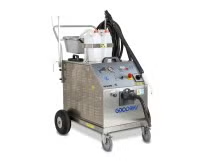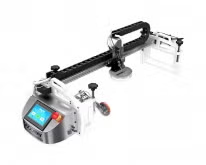Dangerous Pathogens in Food Processing Equipment: Here's How to Protect Your Customers

The Centers for Disease Control in Atlanta, Georgia, has identified about 200 foodborne pathogens. Their ill-effects range from mild intestinal discomfort to death. Listeria, Salmonella and E. coli are three of the most common pathogens in the United States. Producers of ready-to-eat food have to take extra precautions to prevent these pathogens from entering their food production chain.
Pathogens can enter the food production process from a variety of sources, including fouled water at the growing source and improper storage. These pathogens are then spread through contaminated food processing equipment.
According to Evan Reyes, Goodway Technologies' Product Specialist for the food industry, biofilm remains a pervasive problem in the cleaning of equipment. “Biofilm is a thin layer of dead bacteria that hides and protects the living pathogen underneath,” explains Evan. “All food processors need to be concerned about biofilm, but plants that produce ready-to-eat food, such as beef jerky and bologna need to be extra careful,” says Evan.
Though all equipment can harbor biofilm, in Evan’s experience, meat slicers, weighing scales and auto-packagers are the most vulnerable to contamination. “These pieces of equipment have plenty of electronics and nooks and crannies, which make them a challenge to wet clean and sanitize,” he explains.
To clean RTE (ready-to-eat) food processing equipment, wet cleaning and sanitizing are important. However, if you’re not removing hard-to-detect biofilms, your equipment could be harboring pathogens. According to Evan, the best way to protect your equipment and customers is to remove the biofilm layer, so that you can properly sanitize and kill the pathogen underneath.
Goodway Technologies' GVC-18000 helps solve the problem. “Dry vapor steam is the answer,” says Evan. “You superheat water to 290°F with only 5% moisture content,” he continues. “When that vapor contacts stainless steel, you have an immediate heat transfer to the equipment. You cut right through the biofilm layer and kill the bacteria hiding underneath.
Since the steam is dry, it is safe to use around screws, bearings, electronics and sensitive robotics. “A lot of food processing equipment has poor sanitary design,” Evan says. “You’ll find motor cabinets and electronic panels right next to surfaces that need to be wet cleaned. Those areas are hard to clean with standard wet cleaning procedures, or wet steam that uses lots of water.” Once water penetrates electronics and robotic controllers, you start having costly equipment failure.
After you’ve removed biofilms from your equipment, spray and wipe-on sanitizers can do their jobs more effectively. You’re looking for 100% pathogen removal. Close isn’t good enough.





